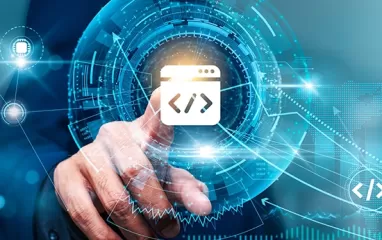Other recent blogs


Let's talk
Reach out, we'd love to hear from you!
Imagine a world where every technological leap—be it Artificial Intelligence (AI) or Machine Learning (ML) that anticipates your needs or a device that seamlessly integrates into your daily routine—comes from a disciplined yet creative process. That process, often overlooked in the dazzle of results, is engineering product engineering.
In 2025, the dynamics of engineering product development evolved to become a fundamental core element of modern business strategy. Modern business operates beyond the traditional role of developers writing code because the product engineering lifecycle combines vision, execution, and adaptability to support innovation and growth.
So, let’s unpack the role of product engineering in modern business, why it’s indispensable for organizations, and how product engineering trends in 2025 are reshaping the future.
What is engineering product development?
Product engineering is a structured and strategic approach to designing, developing, and refining technology-driven solutions that address real-world problems and deliver measurable value. It encompasses the entire lifecycle of a product, from initial ideation and prototyping to development, deployment, and continuous iteration based on user feedback and market demands.
What distinguishes product engineering from traditional software development is its holistic perspective. While conventional development often focuses primarily on functionality—ensuring an application works as intended—product Engineering considers a broader range of factors.
The modern engineering process emphasizes both system operations and user convenience while securing performance standards and security safeguards and promoting lasting system maintenance. The purpose of creating a product goes beyond operational functionality because engineers design systems that deliver excellent user experiences while accommodating changing needs and extending business expansion potential.
At its core, it is a fusion of technical expertise, user-centric design, and business strategy. It demands collaboration across disciplines—software engineering, UX/UI design, data science, cloud computing, AI, and even market research—to create solutions that align with customer needs and business objectives.
Beyond development, product engineering is about bridging the gap between possibility and practicality. It ensures that an idea is feasible, scalable, and market-ready, no matter how innovative. A successful lifecycle requires a fine balance between precision and creativity—translating abstract concepts into tangible, high-performing solutions that not only meet technical specifications but also resonate with users and drive business success.
Why does engineering product development matter for businesses in 2025 and beyond?
Modern-day businesses hinge on their ability to consistently deliver exceptional products. Throughout the journey, it acts as a linchpin in this equation. As of 2025, consumer expectations have soared like never before—people are demanding seamless experiences, rapid updates, and robust solutions tailored to their unique needs. A single misstep, maybe a glitchy launch or a functionality error, can erode trust and market share overnight.
Conversely, a well-engineered product can catapult a company to industry leadership, as seen with organizations like Tesla or emerging AI-driven startups.
The stakes are high because the pace of change is relentless. “businesses can’t afford to treat product development as an afterthought,” said Amit Shrivastava, Director of Product Management at Kellton. “In 2025, product engineering best practices like Agile methodologies, design thinking, CI/CD (Continuous Integration/Continuous Delivery) and DevOps serve as a strategic asset and enable forward-thinking enterprises to innovate faster by letting them adapt to changing market dynamics with superior user experiences.
Revealing specific challenges of engineering product development—and proven solutions
Despite its promise, the product engineering process has its own set of complexities capable of disrupting the entire digital transformation lifecycle. It is a complex process that blends innovation, execution, and collaboration. However, the obstacles mentioned below can lead to inefficiencies, delays, and long-term technical issues. The good news? These challenges can be tackled with proven strategies.
1. Speed vs. quality: Preventing technical debt
Tight deadlines often pressure teams to prioritize speed over quality, leading to technical debt—quick fixes that accumulate and eventually slow down future development. Over time, unoptimized code and workarounds result in performance issues, security vulnerabilities, and high maintenance costs.
Agile methodologies help teams iterate quickly without compromising quality. By working in small, cross-functional teams that make autonomous decisions, organizations can maintain both speed and structure. Additionally, setting aside time for code refactoring ensures technical debt is managed proactively rather than becoming a long-term burden.
2. Cross-team misalignment: Ensuring seamless collaboration
Product engineering involves developers, designers, product managers, executives, and sometimes external stakeholders. Without clear communication and shared priorities, teams experience scope creep, misalignment, and project delays. The best teams operate with a single source of truth, such as shared documentation and regular stand-up meetings to align goals. Tools like Jira, Trello, or Asana streamline project tracking, while Agile practices such as Scrum or Kanban ensure clear roles, responsibilities, and real-time progress updates.
3. Slow and error-prone testing: Automating for efficiency
Traditional software development relies heavily on manual testing, making it slow and prone to human error. Bugs often slip through undetected, leading to production issues that frustrate users and increase operational costs. Automation is key. A well-implemented CI/CD (Continuous Integration & Continuous Deployment) pipeline ensures frequent, automated testing before deployment. AI-powered testing tools can detect issues early, reducing the need for last-minute fixes and ensuring a seamless user experience.
4. Balancing innovation with stability
In the race to innovate, teams often prioritize new technologies and experimental features without fully assessing their long-term impact. Adopting unproven tech stacks or rushing into major architectural shifts can lead to instability, security vulnerabilities, and integration challenges with existing systems.
Successful product engineering teams strike a balance between innovation and stability by conducting thorough feasibility studies before adopting new technologies. Implementing proof-of-concept (PoC) trials and controlled rollouts ensures that new innovations are tested in real-world scenarios before full-scale implementation. Additionally, a strong rollback strategy helps mitigate risks, allowing teams to experiment without jeopardizing system reliability.
Top product engineering trends that are already dominating 2025
As we navigate 2025, several trends are redefining the Product Engineering landscape, offering both opportunities and imperatives for businesses. Here’s a deeper dive into each:
1. AI integration as standard practice
Artificial intelligence has transcended its status as a shiny add-on to become a foundational element of Product Engineering. In 2025, AI will be woven into every stage of the lifecycle, accelerating design through generative models, optimizing code with automated debugging, and enhancing products with predictive capabilities.
For instance, AI-driven analytics can forecast user behavior, enabling preemptive feature adjustments, while self-healing systems reduce maintenance overhead. Amit Shrivastava said, referencing deployments in industries like healthcare and fintech, “It’s not just efficiency; it’s about smarter decision-making at scale.” This trend empowers teams to deliver more robust, responsive products faster than ever before.
2. Sustainable engineering
Sustainability has shifted from a corporate buzzword to a core engineering mandate. In 2025, product engineers will be tasked with minimizing environmental impact without compromising performance. This means designing software that optimizes energy use—such as lightweight algorithms for mobile apps—or hardware with modular, recyclable components.
Sustainability is now a design constraint, not an afterthought because It’s pushing us to rethink everything from server loads to material choices. The result? Products that are both planet-friendly and competitively positioned.
3. Hyper-personalized solutions
Personalization is indeed reaching new heights and it is primarily fueled by real-time data streams and Machine Learning. It is expected in 2025 that products don’t just cater to broad demographics—they adapt to individual users on the fly. Imagine a fitness app that adjusts workout plans based on your sleep patterns or a CRM that reconfigures its interface per salesperson’s habits. This level of customization relies on sophisticated data pipelines and edge AI, ensuring low latency and privacy compliance.
“Hyper-personalization is the new baseline for engagement,” Amit agrees and said users expect products to feel like extensions of themselves. For businesses, this is a retention goldmine—and a technical challenge that product engineers are uniquely equipped to solve.
4. Edge Computing expansion
The proliferation of IoT devices—think smart homes, autonomous vehicles, and industrial sensors—has thrust edge computing into the spotlight. In 2025, product engineers are designing intelligent yet robust solutions that not only process data closer to the source but also help in reducing latency and bandwidth strain.
This shift requires rethinking software architecture for distributed systems, followed by proper optimization of resource-constrained environments including wearables or remote machinery.
For industries like logistics or telemedicine, where split-second decisions matter, this trend is unlocking unprecedented possibilities. This trend isn’t an isolated phenomenon—it is an interconnected force amplifying the role of Product Engineering.
How Kellton helps in positioning product engineering as a strategic imperative?
As we look across the technological innovation horizon of 2025, one thing is very clear: Product Engineering cannot be treated as a peripheral function—it has become a strategic imperative for businesses in the wake of digital transformation. The organizations that succeed this year will be those that treat Product Engineering as a competitive edge because it’s about building with intention—products that endure and evolve.
For business leaders, developers, and innovators, the message is simple: invest in Product Engineering now, or risk being left behind. Want to explore how these insights apply to your organization? Reach out for a deeper discussion. Let’s collaborate to engineer solutions that don’t just meet the moment but define it. The future is waiting—let’s build it together.




